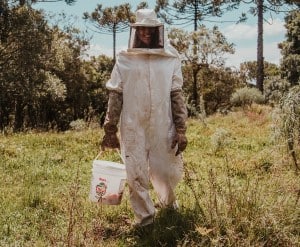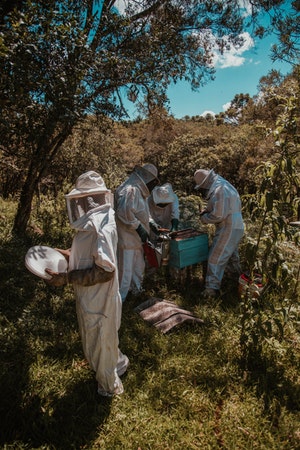As a beginner in beekeeping, protecting yourself from getting stung should be among your main concerns. I mean, you are working with bees, so getting hurt is already a given, but it is still a prospect that a beekeeper is not looking forward to. This article will give you information on which suits would provide the best protection and also keep you comfortable even as a beginner.
What is the safest beekeeping suit for beginners? The most reliable beekeeping suit should be made from sturdy materials that can prevent bee stings from reaching your skin. Suits made from canvas will provide you with the most protection as you work.

However, looking at the many beekeeping suits available in the market, it is hard to tell which ones would be the right one for you. I cannot stress enough that there is no “perfect” suit out there, but there are suits that are perfect for you.
Table of Contents
Characteristic of an Ideal and Safe Beekeeping Suit
I’ve said this before, and I will repeat it, safe doesn’t mean it’s ideal. You’ll find that from the many choices of beekeeping suits available, some are just not right for you. But, there are ones that address the current issue you have and perform admirably too.
Size and Fit
While your beekeeping glove needs to have a snug fit and sort of mold to your hands, a beekeeping suit should be loose. It doesn’t have to be too free but loose enough to allow ease of movement as you work in your apiary. Remember that you will be bending, twisting, and making lots of actions as you inspect your hives. The right size suit should allow you to perform all your job without impediment on your movements. Snug fitting suits will restrict you, and loose fitting ones can be just as uncomfortable.
Protection Level
The safest beekeeping suit is the ones designed to provide you with the highest level of sting protection. Beginner suits are mostly made from sturdy and thick material that prevents the bees from reaching your skin when they sting. Expect these kinds of suits to be heavier, bulkier, and harder to slip in and out of. This will increase the cost, unfortunately, but we’ll come on to costs later.
Comfort
A suit that lets you move and perform effortlessly without it feeling like you are inside an oven on a hot summer day is the ideal one, in terms of comfort. Some suits provide that kind of support to beekeepers, and many attest to the fact that the suit, which allows air to pass through it, is one of the well-spent cash when it comes to beekeeping.
Material Used
Beekeeping suits can be made from cotton, nylon, canvass, or a combination of the three. The one that offers you the most protection is the one constructed from the canvass. Others prefer cotton because it is a breathable cloth compared to the canvass. Now some jackets are made from nylon, but a little birdie told me that nylon produces static electricity which the bees don’t like. Another beekeeper also mentioned that any material that has loose fibers (like wool) should also not be used as bees tend to tangle in them.
Full Suit or Just a Jacket for Safety?
We know that some are not that keen to put on a coverall beekeeping suit, which is why there are also beekeeping jackets available on the market. They say that coveralls make it hard for them to move and at times make them clumsy. Jackets, on the other hand, are much more convenient and more comfortable to put on and take off.

Full body suits are used by many, especially beekeepers employed by large corporations. It provides the overall wearer protection from the bees, most notably the ones made from the canvass. On the other hand, jackets are more for the backyard beekeeper individuals. It offers the wearer reliable protection from the waist up if worn with a veil. There are ones sold with a veil already attached via a zip attachment, and there are also some that don’t include the veil.
As for what to choose between the two depends significantly on where you are going to use it. If you manage an apiary with a considerable number of hives (more than 20 hives, maybe), then wearing a full suit would be the best choice as it provides you with complete body protection. Beekeeping jackets, on the other hand, can be used by beekeepers who work with fewer hives. They can pair this jacket up with thick denim or the pants that painters used to protect their clothing.
Another reason to wear full body suits is when you would be working with an extremely aggressive bee species. Field experts who conduct study and research of Africanized Honey Bees, always wear beekeeping coveralls made from canvas to provide them with the utmost protection.
Price Range of Beekeeping Safety Suits
Depending on the material used, a full body suit can range from between $50 to $260, maybe even more. The suits that are made from canvas are the cheapest ones while the suits made from 100% cotton are the most expensive ones. Nylon and the Polycotton combination have prices that are somewhere in between.
Jackets are also priced differently depending on the material used and if a veil is included. Heavy-duty jackets with veils costs around $44 each while ventilated ones with veil are about $72. The cheapest one you can get is the pullover type, which is about $25 or even less if you find one on sale. Some jackets are sold without veils, meaning you have to buy the veil separately which costs around $14 – $16
Full body suits offer overall protection, so they are much pricier than the jacket ones. However, if you want to get a good deal out of your money, then buying beginners set would be the best way to go. Most sets would include a coverall suit or a jacket, a veil hat or veil helmet, and gloves. The ones that contain just a jacket cost $20 to $80 a set while the set that has a full body suit costs $150 to $300, all depending on the material used in the construction of the items. If you are lucky, you might find sets that include, a bee brush and a hive tool!
Keeping The Suit Safe
Keeping your suit safe and clean should be a priority of yours. A designated area where your suits can hang after you use them would be ideal. As for cleaning it, it depends on what material your suit is made of. Canvas ones need to be soaked before throwing it in the washer, while cotton, nylon and polycotton blends can be thrown into the washer directly.
Many suggest that you use a mild detergent with warm water to wash off any honey or wax that is on your suit. The mild detergent would extend the life of your jacket, but regular soaps also work. Chlorinated water or bleach can help in removing stains if you want it to remain pristine white but be careful of damaging the fabric with strong chemicals.
Did you know? There is a reason why beekeepers wear white suits or light colored suits when working with bees. Dark colors tend to attract bees to sting you more because bears in the wild are usually dark brown or black. Light colored fabrics do not trigger the instinct of the bee to attack.
I Don’t Want To Buy, Can I DIY?
Yes, you can. If you have thick rubber gloves or sturdy gardening gloves, you can use that as an alternative to beekeeping gloves. Just make sure that you close up the opening with an elastic to prevent bees from entering. A thick leather jacket can be used as a beekeeping jacket alternative, especially the ones that have a zip closure. Thick denim jeans can be your pants of choice with ankle length boots. Again, don’t forget to close the ends with elastics.
As for the veil, I saw a DIY one made from an old bike helmet! The person who constructed it glued some cardboard around the helmet and then he cut up a store-bought pantyhose and glued it around the cardboard (genius).
It is up to you if you want to buy or DIY your beekeeping protective clothing. As long as the clothes are doing its job of protecting you, I see no harm in using them as an alternative.
Conclusion
To sum it all up, the safest suits are the ones that are designed for heavy-duty purposes, and most professionals handling a generous amount of bees would benefit from this. Beginners are also advised to purchase this type as this is the one that will provide you with the best protection. We recommend that a full bodysuit (not the jacket type) should be among the first items a beginner buys since it offers 360 degrees security. Ventilated ones are also available to increase the comfort level while you work as it allows air to pass through. Wash your suit regularly with warm soapy water and have a designated area where you can hang it. Lastly, buying a suit is a must but is optional as you can DIY your protective beekeeping suits from the old items in your closet.
Don’t forget to promote the current situation of our bees and also to have fun as you learn more!
